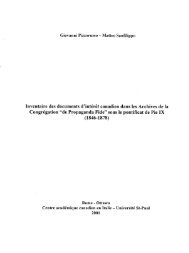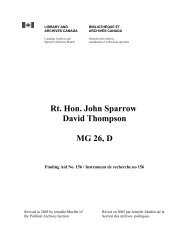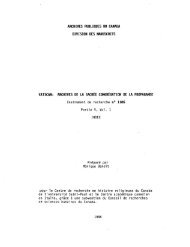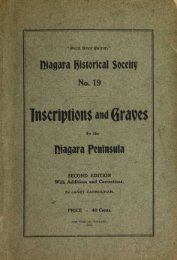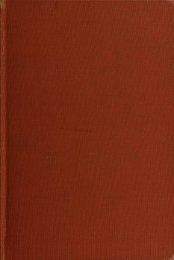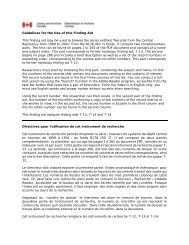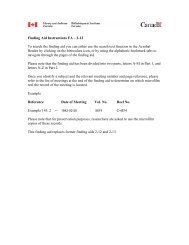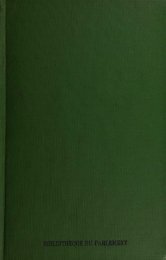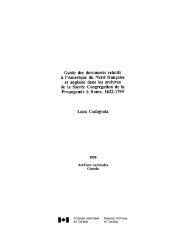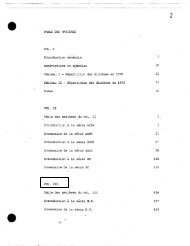Guide to Documents Relating to French and British North America in ...
Guide to Documents Relating to French and British North America in ...
Guide to Documents Relating to French and British North America in ...
Create successful ePaper yourself
Turn your PDF publications into a flip-book with our unique Google optimized e-Paper software.
its way <strong>to</strong> Rome. In fact, the Newfoundl<strong>and</strong> Catholics soon welcomed O'Donel <strong>to</strong> their isl<strong>and</strong> -- the<br />
very priest <strong>and</strong> person for whom they had asked.<br />
This small <strong>in</strong>cident is a good example of the relationship that existed <strong>in</strong> the seventeenth <strong>and</strong><br />
eighteenth centuries between the Catholics of <strong>North</strong> <strong>America</strong> <strong>and</strong> the Holy See. It is an extreme<br />
example only <strong>in</strong> the sense that the whole hierarchical ladder is represented <strong>and</strong> that all steps were duly<br />
recorded. (In most cases, there was a more direct way of reach<strong>in</strong>g Rome, or it may only seem so<br />
because not all documents are extant.) This chapter will exam<strong>in</strong>e the general framework of the<br />
relationship between Rome <strong>and</strong> <strong>North</strong> <strong>America</strong>, the way the Holy See shaped its <strong>North</strong> <strong>America</strong>n policy<br />
<strong>and</strong> whether this changed over time. It will also briefly discuss whether it is possible <strong>to</strong> determ<strong>in</strong>e the<br />
impact of the Holy See upon the his<strong>to</strong>ry of <strong>North</strong> <strong>America</strong>.<br />
2. THE SEVENTEENTH CENTURY<br />
When, at the beg<strong>in</strong>n<strong>in</strong>g of the seventeenth century, France <strong>and</strong> Engl<strong>and</strong> decided <strong>to</strong> add the New<br />
World <strong>to</strong> their maps, they found that Spa<strong>in</strong> had left unoccupied most of what is now Canada <strong>and</strong> the<br />
United States, <strong>and</strong> was <strong>in</strong> no position <strong>to</strong> cont<strong>in</strong>ue its previous massive colonial effort. They began the<br />
acquisition of their <strong>America</strong>n empire at r<strong>and</strong>om. Port-Royal was established <strong>in</strong> 1605, James<strong>to</strong>wn <strong>in</strong><br />
1607, Quebec <strong>in</strong> 1608, <strong>and</strong> Cuper's Cove, Newfoundl<strong>and</strong>, <strong>in</strong> 1610. Bermuda was first settled <strong>in</strong> 1612,<br />
<strong>and</strong> the Pilgrim Fathers l<strong>and</strong>ed <strong>in</strong> Plymouth <strong>in</strong> 1620. At first, profit was the only measure of a colony's<br />
success <strong>and</strong> therefore plans were cont<strong>in</strong>ually made <strong>and</strong> unmade, both by <strong>in</strong>dividual entrepreneurs <strong>and</strong><br />
by governments, accord<strong>in</strong>g <strong>to</strong> the immediate <strong>in</strong>come from the colonies. Some fifty years passed before<br />
France decided that its colonies had grown <strong>to</strong>o important <strong>to</strong> be left <strong>in</strong> the h<strong>and</strong>s of a number of semiprivate<br />
commercial companies <strong>and</strong> before it tried <strong>to</strong> centralize the colonies' adm<strong>in</strong>istration. Jean-<br />
Baptiste Colbert attached the colonies <strong>to</strong> the M<strong>in</strong>istry of the Mar<strong>in</strong>e. Difficulties arose from overlapp<strong>in</strong>g<br />
responsibilities, <strong>and</strong> it was found that commis were not always experts <strong>in</strong> colonial affairs. The rivalry<br />
between the <strong>French</strong> colonial governor <strong>and</strong> the <strong>in</strong>tendant was theoretically resolved by the central figure<br />
of the K<strong>in</strong>g. In most cases, however, this rivalry was fostered by the K<strong>in</strong>g himself, who wanted <strong>to</strong><br />
limit the powers of his two officials. As for Engl<strong>and</strong>, it never had a central agency that controlled the<br />
development of the thirteen cont<strong>in</strong>ental colonies or any of its West Indian possessions, let alone a plan<br />
for their establishment. The Board of Trade, created <strong>in</strong> 1669, had only advisory powers. Any f<strong>in</strong>al<br />
decision rested with the Privy Council, whose members dealt with the whole range of government<br />
decisions. 3<br />
Dur<strong>in</strong>g the sixteenth century, Spa<strong>in</strong> <strong>and</strong> Portugal had occupied most of Central <strong>and</strong> South<br />
<strong>America</strong>. S<strong>in</strong>ce both were Catholic countries, Catholicism had played a vital role <strong>in</strong> the early conquest<br />
of <strong>America</strong>. Catholicism <strong>in</strong> fact had been the ideology of the Conquest. Paradoxically, Rome had<br />
almost no part <strong>in</strong> it. By virtue of the so-called royal patronage, the Pope had delegated all spiritual<br />
powers over Spanish <strong>and</strong> Portuguese possessions around the world <strong>to</strong> their respective k<strong>in</strong>gs. The<br />
religious orders, which operated <strong>in</strong> Central <strong>and</strong> South <strong>America</strong>, <strong>and</strong> which played such an important<br />
role <strong>in</strong> the conquest of the New World, because of royal patronage were responsible <strong>to</strong> their Iberian<br />
k<strong>in</strong>gs, not <strong>to</strong> Rome. The Pope had <strong>in</strong> fact conf<strong>in</strong>ed himself, <strong>in</strong> the early stages, <strong>to</strong> draw<strong>in</strong>g a l<strong>in</strong>e<br />
separat<strong>in</strong>g <strong>and</strong> establish<strong>in</strong>g <strong>in</strong> perpetuity Spanish <strong>and</strong> Portuguese <strong>America</strong>. 4<br />
Although some suggested, <strong>in</strong> the l640s, that the Pope, like any other pr<strong>in</strong>ce <strong>in</strong> Europe, should<br />
have his own colonies,S the Holy See, unlike France <strong>and</strong> Engl<strong>and</strong>, had no colonies. From 1622 on,<br />
however, it did have a central agency <strong>to</strong> deal with these "Catholic" colonies, or, more precisely, <strong>to</strong><br />
profit from other countries' efforts <strong>to</strong> build <strong>and</strong> ma<strong>in</strong>ta<strong>in</strong> colonial empires. In 1622 the Sacred<br />
Congregation "de Propag<strong>and</strong>a Fide" was established <strong>to</strong> spread the true faith among the <strong>in</strong>fidels, <strong>to</strong><br />
protect it where Catholics lived side by side with non-Catholics, <strong>and</strong> ultimately <strong>to</strong> achieve union with<br />
the Protestant <strong>and</strong> Orthodox churches. The new Congregation was meant <strong>to</strong> pursue these goals by co-<br />
2




